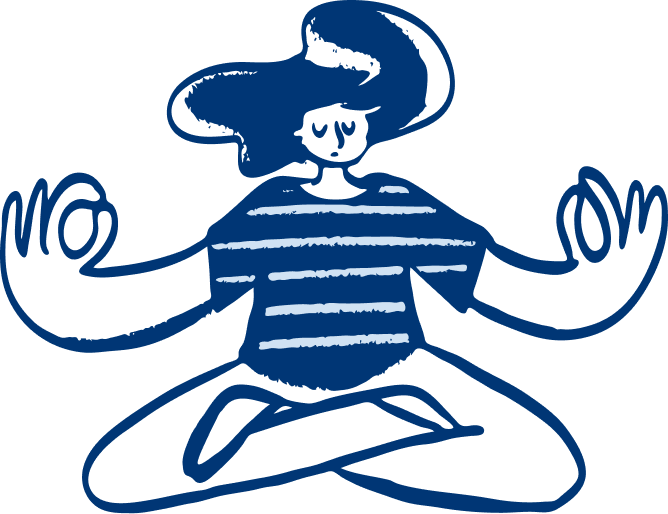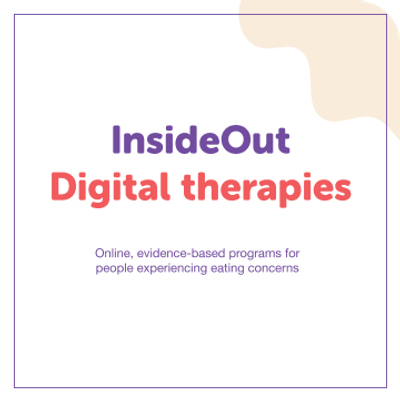Short-term help for managing eating challenges and EDs
Exploring ways to manage eating challenges (disordered eating), eating disorders (EDs), and/or body image struggles is a meaningful step towards feeling more supported and in control.
It’s normal for things to feel overwhelming or unclear right now, but you don’t have to face it all at once. This page is here to offer simple, practical strategies to help you feel more grounded in the moment while guiding you to the information and support that’s right for you.
On this page, you’ll find information on:
Scroll down to learn more.
What can I try now?
If you’re feeling distressed or unsure where to start, a grounding technique can help you return to the present moment. The 5 senses technique, for example, can help you feel more connected to your surroundings, ease intense emotions, and take your focus off racing thoughts or physical sensations.
Whether you’re feeling stressed during a meal, overwhelmed by body image thoughts, or struggling with urges, this technique is a simple and accessible tool to help you find calm. It’s something you can use anytime, anywhere, to feel more grounded and supported.

Coping strategies to manage distress and overwhelm
Some days, you might feel ready to take on the world. On other days, simply getting out of bed can feel impossible. However you’re feeling, it’s okay.
Having a few simple go-to strategies can help you feel calmer, in control, and better equipped to face eating challenges and EDs. Below, you can explore practical techniques designed to support you wherever you are.
Keep in mind that everyone is different, so what works for someone else might not work for you. The main thing is to keep experimenting until you find what feels right.
- Deep breathing
When stress or anxiety feels all-consuming, whether during a meal, after a triggering comment, or in moments of self-doubt, deep breathing can help ease both physical and emotional tension. It slows your heart rate, calms your mind, and makes it easier to face overwhelming thoughts.
How to do box breathing:
- Inhale deeply through your nose for a count of 4
- Hold your breath for a count of 4
Exhale slowly through your mouth for a count of 6 - Repeat until you feel calmer and more in control.
Try it now: Use our guided box breathing video to practise this calming technique.
- Practise mindfulness and meditation
- Do a self check-in
- Reach out to someone you trust
- Distract yourself with a self-care activity
Coping strategies like these aren’t about solving everything all at once. They’re about creating moments of relief and reclaiming a sense of control.
Every time you pause to care for yourself, you’re making meaningful progress, even if it doesn’t feel that way right now.
Lifeline is here for you.
Eating challenges and EDs can lead to thoughts, feelings, and behaviours related to suicide.
If you're feeling overwhelmed or in crisis, you can connect with Lifeline 24 hours a day, 7 days a week via 13 11 14, text, and chat. We’re here to listen to whatever it is you’re going through.
Tips for recognising and managing triggers
Reflecting on your relationship with food, your body, and your emotions can be an important step in understanding your needs. Online tools, like self-assessments from InsideOut, offer a gentle, non-judgemental way to explore what might be going on and identify areas where you’d like support.
These assessments can help you uncover patterns and gain insight into your experiences, offering clarity on the types of support or guidance that could feel right for you. Noticing the situations, emotions, or moments that make things feel harder can help you make sense of your experiences and find ways to respond with kindness and care.
Keep in mind that awareness isn’t about blame or self-judgement. It’s about creating space to gently explore what’s happening beneath the surface. By reflecting on your triggers, you might begin to uncover patterns that offer clarity and show you where support or boundaries could help.
What are triggers?
Triggers are anything that can intensify difficult thoughts, feelings, or behaviours. They might be specific situations, emotions, or even small everyday moments.
Common triggers include:
- Stress or anxiety: Feeling overwhelmed might lead to using food or exercise as a way to regain calm or control
- Low self-esteem or self-criticism: Negative self-talk about your appearance, abilities, or worth can reinforce unhelpful patterns
- Difficult emotions: Suppressing feelings like sadness, frustration, or anger might seem easier at first, but these emotions can build and feel harder to manage later
- Social events: Gatherings around food can bring feelings of discomfort, worry, or comparison, especially when there are unspoken pressures
- Media messages: Social media, advertising, or even health campaigns can amplify feelings of self-doubt or fuel harmful comparisons
- Conversations about weight or appearance: Even well-meaning comments about body size, shape, or dieting can feel overwhelming and reinforce unhelpful thoughts.
Remember - recognising your triggers is about building awareness so you can approach them with self-compassion and feel more prepared to manage them.
Create a trigger management plan
Once clear on what your potential triggers are, you can start to think of what you can do to feel calm and in control. Having a plan like the one below is a great way to anticipate difficult situations, recognise how they might affect you, and have strategies ready to navigate them.

Set boundaries
Boundaries are personal limits that protect your emotional, mental, and physical wellbeing. They’re not about pushing people away but about creating space to focus on what you need to feel supported and safe. They can also help others understand how you’d like to be supported.
Here are some examples to consider:
- Limit conversations about food and weight
Conversations about dieting, weight, or body image can be triggering. Setting boundaries around these topics can help create a safer space.
You can say:
- ‘I’d prefer not to talk about diets or weight. Can we focus on something else?
- ‘I’m working on feeling better about myself, so I’m avoiding conversations about food or bodies right now.’
- Create personal space during meals
- Protect your energy and emotional wellbeing
Practising how to express your boundaries with a trusted friend, or even in front of a mirror, can help you feel more confident. It’s normal to feel nervous at first, but the more you practise, the easier it will become.
For more tips on building confidence and protecting your mental health, check out our article on self-esteem. To learn more about managing eating concerns and EDs in the long term, head to our long-term help page.
Show self-compassion
Healing can feel messy at times, but treating yourself with kindness can ease the journey. Self-compassion means offering yourself the same care and understanding you’d show a friend.
If it feels right, try to:
- Reframe setbacks: Instead of seeing challenges as failures, view them as part of the process
- Use kind self-talk: Replace harsh inner dialogue with affirmations like, ‘I’m doing my best, and that’s enough.’
- Create a comforting ritual: Whether it’s journaling, enjoying a warm drink, or simply pausing to breathe, find small ways to show yourself care.
Every act of kindness toward yourself is a step toward greater self-acceptance and peace.
Remember - you're not alone
It’s important to remember that you don’t have to face this journey by yourself. There are people who have been in your shoes, who understand the challenges you’re going through, and who want to help you feel supported and heard.
Butterfly is a leading organisation in Australia offering free, confidential support for people experiencing eating challenges, an ED, or body image struggles. Their trained counsellors provide a safe space to share what you’re feeling and help you navigate your next steps.
Whether you need someone to listen to what you're going through, information about eating disorders, or guidance to connect with the right services, Butterfly can help.
If Butterfly doesn’t feel right for you, you can always contact Lifeline. We’re here to support you with understanding and compassion, no matter where you are in your journey. You are never alone in this. There is help, and there is hope.
Click here to learn more about what to expect when contacting Lifeline.
Click here to download, save, or print our eating and body image fact sheet.








